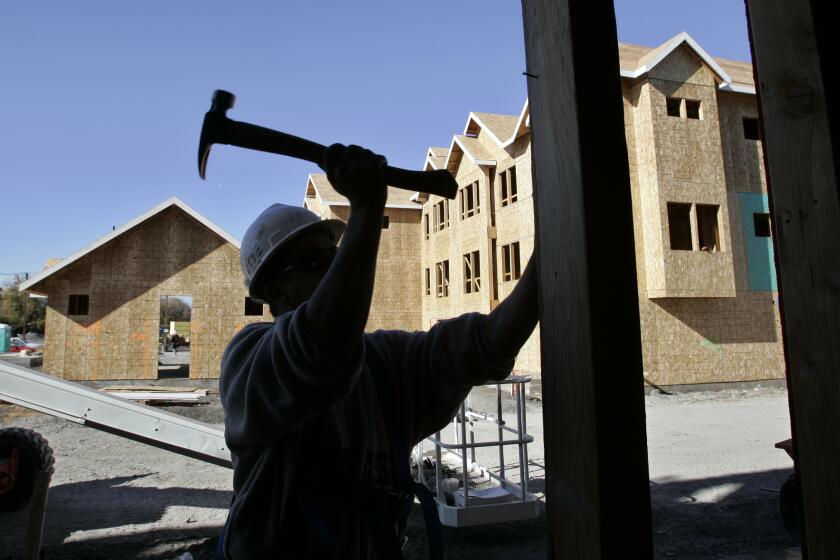Getting through that condo remodel means taking extra steps
Architects and husband-and-wife team Apurva Pande and Chinmaya Misra’s most difficult condo renovation project was one that had sounded so simple: Combine a client’s two downtown Los Angeles lofts into one.
Instead, the principals of architecture firm CHA:COL encountered what they called a Gordian knot of complexity.
In condos, another layer of scrutiny exists: the homeowners association, with its set of rules, commonly called “covenants, conditions and restrictions.”
“We had to get HOA approval, so we submitted details to them beforehand. And then, once you get that, you have to take those plans to the city,” Pande said. “We must have worked through seven different city agencies — [the departments of] fire, building and safety, even planning and the community redevelopment agency — but we finally got it done.”
Working in condos means preparing for complications. Unlike with single-family homes, condo owners own only what’s within the walls of their units. Everything else — common areas, plumbing, roofs, exterior areas, sometimes even balconies — are owned by all the residents of the complex, which means neighbors have a stake in what you do.
That means abiding by the rules of the complex, which governs what hours contractors are able to work (usually shorter than is allowed by the city, hampering the speed of your renovation), how they are able to get materials into and out of your unit (typically through a service elevator), and even where contractors can park.
For Pande and Misra’s downtown loft project, they worked with a contractor who conducted a pre-construction visit just so he could inspect the door size of the small service elevator, the corridor width, distance from parking to elevator, and turning clearances to make sure everything brought into the building would fit.
Despite the logistical challenges and numerous agency approvals, they made the condo combo work.
The now-3,100-square-foot unit is one space, with all the entertaining sections in what used to be one unit and the sleeping areas in the other.
The combined space was woven together by two sleek extra-large furniture pieces designed by the firm. It delineated the loft’s separate areas and also provided attractive shelving and storage.
When it comes to tackling condo projects, early and ongoing communication is key, said interior designer and lawyer Breeze Giannasio — who once worked at Hirsch Bedner Associates, the largest hospitality design firm in the world — “and being respectful of your neighbors, because you’re not operating in a vacuum. You’re in a larger building ecosystem.”
Giannasio most recently worked on a renovation of a two-bedroom, two-bathroom Los Angeles condominium owned by Mila Kunis’ parents as part of makeover series “My Houzz.”
Kunis found the kitchen isolating, so the actress worked with Giannasio to try and open up the space, which meant tearing down multiple walls.
At one point, they were unpleasantly surprised to find a structural column. Instead of spending the money to remove it, Giannasio designed the kitchen entry to look like a large cased opening to give the unit more architectural detail, incorporating the structural column into the design.
Most of the time, all units in a condo have to look the same (i.e., use the same color paint on the doors, have the same window frame), but there are cases when exterior changes are permitted. It all depends on your HOA.
For a 1,060-square-foot one-bedroom, one-bathroom unit at Shoreham Condos in West Hollywood, Lucie Ayres of 22 Interiors was able to get permission to turn part of a balcony into an indoor area, which added 40 square feet of space to the master bedroom. She theorized that the major change was approved because the balcony faced the hills and not the street.
To make everyone’s life easier, Ayres offers this tip: “I always ask the building reception, residents or property managers if there are contractors they can recommend. The same goes for handymen, painters, anyone in trade.”
Although residents should always get multiple bids, “contractors who are familiar with the building will save you a ton of time, since they already know where the pipelines, vents and other details are.”
With the Shoreham Condos project, Ayres used a contractor who had already worked on a few other units in the building and was well-liked by residents, “which made for a smoother process overall.”
“The biggest bonus was that he was always in the building,” she said, “so even when finished, if small punch-list type items needed to get done, he could have his crew handle it quite quickly and efficiently.”
More to Read
Sign up for Essential California
The most important California stories and recommendations in your inbox every morning.
You may occasionally receive promotional content from the Los Angeles Times.






